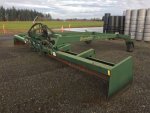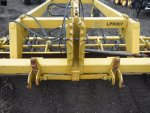Making a land plane from what you got....
The last time we did a major regravel of our 1/2 mile road, the truck did a pretty poor job of evenly layering the new gravel on the road.. lots of humps.
Trying to use a short wheel base tractor with rear blade is a real PIA in trying to get the road evened out..
Thought about a road scraper with the blade suspended in the middle of a long wheel base and came up with this idea that effectively suspends the rear blade over a much longer wheelbase.
I already had the trailer hitch on the blade as shown below. I added the chain attachment point at the bottom of the blade as shown and with a similar mount on the trailer tongue 5 feet back of the trailer hitch coupler. Using the geometry of the trailer tongue & adjusted chain length in opposition of the angle of the blade limited by the 3 point hitch of the tractor, effectively limits the height the blade can go down, averaging over the distance between the tractor rear tires and the trailer rear tires which are approximately 18 - 19 feet apart.
It's not centered as the blade touches the ground about 6 feet behind the center line of the rear tractor wheels and 12 feet from the trailer wheels, but that is a huge improvement over the blade suspended by the tractor alone.
Once the chain length is properly adjusted and some minor tweaking of the 3 point lift height setting and top link on the 3 point hitch (old Ford blue has multiple top link attach points that can be used to accentuate the rotation of the blade as it is raised and lowered) it does a nice job of scraping down the high spots and filling in the low spots..
Using chain for the lower link on the trailer works well for turning, as when I lift the blade the chain goes slack and I can make sharp U-turns as usual to turn around.
As mentioned several times above, one needs to visualize the geometry of this arrangement (or see it in action) to understand how this works.. As the blade is lowered with the trailer attached, the 3 point hitch is effectively moving the two chain attachment points further away from each other.. Once the chain goes tight, the blade will not lower any further. Tractor 3 pt hitch doesn't resist the lift/support of the blade by this extended "truss" arrangement as this particular 3 pt hitch hydraulics is lift only, can't exert down force.




